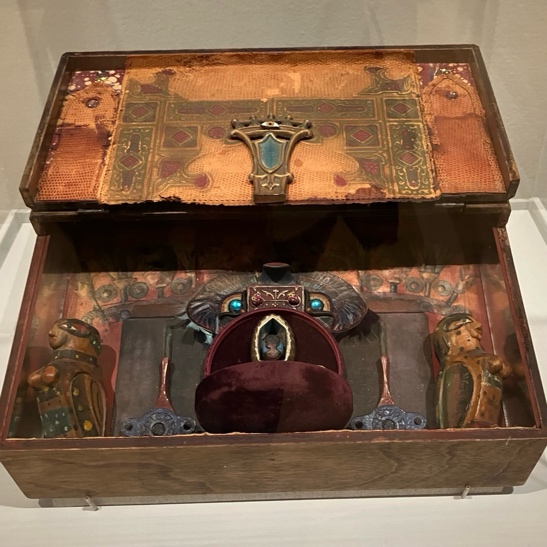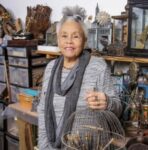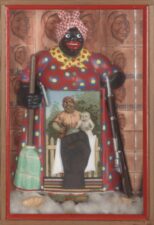
Betye Saar
American, 1926
Memories of Kemi, 1974
Assemblage, Mixed Material
3 5/8 x 11 5/8 x 11 1/2 in. (open) 3 5/8 x 11 5/8 x 7 3/4 in. (closed)
SBMA, Gift of Dr. and Mrs. Arnold Chanin
1979.50.1

Betye Saar, (Field Museum on-line publication. July 2021)
“Curiosity about the unknown has no boundaries.
Symbols, images, places and cultures merge, time slips away.” - Betye Saar
RESEARCH PAPER
Betye Saar was born in 1926 in Los Angeles; she lives in Los Angeles today. She is a formidable figure in art. She was a driving force behind the Black Arts Movement and the Civil Rights Movement from back in the 1960’s. Her UCLA undergraduate degree was in design, but she came to art after first working as a social worker. Saar garnered success as a printmaker and creator of wonderful sculptures and assemblages that use “found objects”.
Betye Saar is probably best known for her seminal work, “The Liberation of Aunt Jemima” from 1972. In this assemblage, she used a ceramic image of a “mammy” in the center of the piece. The woman is dressed in a red and white bandana with a flowered dress. The image holds a broom in one hand. Saar tucked a hand grenade under Aunt Jemima’s arm and gave her a rifle to hold in her other hand.
Saar took a derogatory and racist image of a black woman and completely changed it; she gave this image power and agency in a world full of hateful stereotypes. As Saar noted, Aunt Jemima was finally liberated (retired as a brand image) almost 50 years later in 2021. “Liberation” was one of the many art works by Saar that challenged negative, racist images.
Saar is also known for her assemblages that draw on spirituality, cultural histories, and memories. “Memories of Kemi” is one of these works. The assemblage is contained inside an old wooden box. The box has a strong clasp, but it sits open before the viewer. Inside there is a beautiful cameo of a young woman in the center. The cameo rests inside a metal shrine, with a glowing blue background. The tiny shrine is placed inside a small velvet jewelry box. There are two small amulets on either side of the jewelry box. The assemblage also includes decorated wooden birds, embossed snakeskin leather, and feathers displayed gracefully above the cameo.
Jewels sparkle in the box lid and from a broach above the cameo. In the center of the lid, above a large jewel, there is a single eye staring out. The items are arranged carefully; each item seems to be positioned with love and meaning. There is no accompanying narrative that tells us what the items mean; Saar lets her audience create their own stories for this work.
Who was Kemi? The artist does not give the viewer this information. Kemi is a woman’s name; a nickname, shortened from the full name Olukemi. The name means “God takes care of me” in the Yoruba language from the region of southwestern Nigeria and Benin.
This assemblage invokes memories of a woman with a beautiful name. Saar challenges us to think about how we catalog and remember people in our lives. When someone dies, do we only think of their career, their family, their “accomplishments” – the information that appears in an obituary? What about all the small, personal details of life - the little items from someone’s life that add another dimension? How do our small possessions define us? What do these objects tell others about us?
Saar’s art studio is filled with found items from her travels around the world. She also collects objects from yard sales and flea markets. She systematically organizes everything so she can craft assemblages based on ideas, colors, feelings, and causes. Sometimes she is inspired by a found object and sometimes she hunts down an item to represent her ideas. In her assemblages, both the selection of her curated art items and their juxtaposition have meaning and importance.
Betye Saar was quoted in the New York Times Style magazine - “I’ve always felt that old objects hold a power...They’ve survived, and they have a sense of the previous owner. They have a spirit.” Saar has a deep understanding of the history of her artistic elements and uses this knowledge to create powerful compositions.
In the last five years, Saar has had major shows at both the MOMA (Museum of Modern Art, New York) and the Los Angeles County Museum of Art. Her works are owned and shown in museums across the country; her art is well-known and respected.
As of this writing, Betye Saar is 98 years old, and she is still making new art. Her energy, creativity, and imagination allow her to continue. She creates art pieces that inspire viewers to consider new perspectives.
Prepared for the Santa Barbara Museum of Art Docent Council by Carol Forhan, 2024
BIBLIOGRAPHY
Adler, Esther. Associate Curator, Department of Drawings and Prints, Museum of Modern Art (MOMA). “Betye Saar”. https://www.moma.org/artists/5102
Altschul, Serna, interviewer. “Assemblage Artist Betye Saar”, CBS Morning Show. February 23, 2020.
https://youtu.be/T7CFz9xzhIM?si=s5oRDxH9czCfmysu
Brown, Evan Nicole. “Betye Saar Remains Guided by the Spirit.” New York Times Style Magazine. New York, May 8, 2024. https://www.nytimes.com/2024/05/08/t-magazine/betye-saar-huntington-roberts-projects.html
Russell, Bridget. “How a Visit to the Field Inspired Betye Saar’s Art”. Field Museum on-line magazine. July 30, 2021. https://www.fieldmuseum.org/blog/how-visit-field-inspired-saars-art
Saar, Betye. Artist’s website. https://www.betyesaar.net
Steward, James Christen; Willis, Deborah; Jones, Kellie; Smith, Richard Candida; Simes, Lowery Stokes. “Betye Saar: Extending the Frozen Moment.” University of Michigan Museum of Art. University of California Press, Berkley, 2005.

Betye Saar, The Liberation of Aunt Jemima, 1972. Berkeley Art Museum and Pacific Film Archive, Berkeley, California. Photo by Benjamin Blackwell. Courtesy of the artist and Roberts & Tilton, Los Angeles, California.
